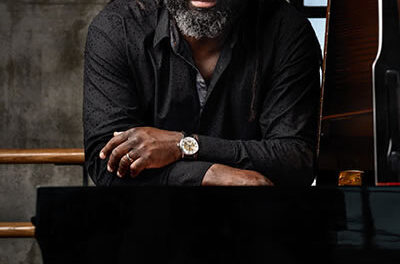Kola Owolabi began with Bach’s Toccata, Adagio, and Fugue, S. 564, from memory. The good people of St. Paul’s Episcopal Church reverse the chairs for organ events, putting the performer on sharp display. In the pedal solo Owolabi could be seen adding and subtracting a big pedal reed with his right hand between phrases, creating an echo effect. When the keyboard line returned, the entry was as smooth as butter! The pedal was a little overpowering against the manual registration. From the keyboard entry on there was a lot of toe stud work changing the registration, unwise in my opinion, especially with a performer as skillful as Owolabi who has a tremendous sense of phrasing and nuance in his playing. The embellishments to the text were definitely in line with what is known of performance practice in Bach’s time. The Adagio, on cornet, was brisk and singing, with lots of optional coloratura and ornaments. The registration changed to a very somber color for the chordal passage of the Adagio. The Fugue, at a fast clip (but not excessive) was effortless, perfect, transparent, joyful. At the conclusion, my companion, who has sat through several headache makers on this organ, said, “Now that’s what this organ ought to sound like!”
Karg-Elert’s Cantilena, from Zehn Characterische Tonstücke, Opus 86, was distinctive for its multitudinous registration changes; the sound alternated between very picnic-y and forcefully loud.
The Toccata (1996) of Stephen Paulus (born 1949) is quirky but highly musical and largely harmonious. It’s a large piece, constantly ranging over the whole keyboard and pedalboard, then lapsing into brief, painful atonal chords or tone clusters. Owolabi’s playing was fluid and seamless even as the music called for ballet-like leaps and jumps of fingers and legs. But no eurhythmics! Owolabi’s back was as motionless as a beetle pinned to a card in an insect collection, very much reminiscent of Gustav Leonhardt, Anton Heiller, or a mountain fiddler, even when he was gracefully hanging onto the bench for dear life! Not stiff, by any means, but calm, tranquil, focused.
The Allegro vivace from Widor’s Symphony V was played from memory, with a comfortable tempo and bright but gentle registration for the beginning statement of the theme. It was precise, precise, precise with a cuteness totally appropriate to the somewhat tongue-in-cheek theme before the first big variation. How nice to have a player of this quality play the Fisk; a player with a good understanding of the instrument’s resources and the limitations of the room and how to use them. Owolabi’s registrations ran the gamut from soft to loud, but never too loud; and without the extended deafening passages that have been heard here in the past; the occasional forte was used judiciously.
The Prière of César Franck offered an almost violent contrast to the Widor. Owolabi had, in spoken remarks, pointed out the well-known contrast between the emotional, expressive style of Franck and the precise and workmanlike approach of Widor. Owolabi played masterfully, with pauses for the building to clear/catch up and pauses for several little false endings, but the big sound (probably right in line with what Franck would have wanted) was at variance in my mind with the solemn nature of the composition. At the very end there was a descending broken chord emphasized by a perfectly synchronized closing of the swell box that was so exquisite that it by itself was enough to make the recital totally memorable.
The closing piece was Marcel Dupré’s haunting Prelude and rousing Fugue, Opus 7, No. 3, again from memory. To use the exaggerated style of Dupré’s time, the melody in the Prelude moved slowly among a forest of wood nymph notes on the flutes; then there were chordal progressions on the strings. The Fugue, with its unmistakable and famous theme “Marcel Dupré, Marcel Dupré, the hell you say, Marcel Dupré,” was clear at the beginning but had some muddy passages that if anything were attributable to the building.
Owolabi played brilliantly!











